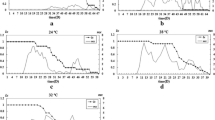Abstract
The ecology and physiology of a free-living mite species Antarcticola meyeri, Cryptostigmata, rarely discovered in the Continental Antarctic Zone, were studied near the Japanese Antarctic Base, Syowa Station. The distribution of this mite species correlated noticeably with the distribution of its food, the imperfect lichen species, which grow in moss carpets. Within a limited habitat, this mite species preferred dry carpets to wet carpets. Low humidity appeared disadvantageous to the species at high temperatures (ca. 30°C), but at low temperatures (ca. -25°C), low humidity appeared advantageous. This may explain why this species preferred dry carpets. The mean supercooling point of starved individuals was -30.6°C (nymphs) to-33.9°C (eggs). When fed with lichens, however, it was significantly raised, probably because the gut contents functioned as ice nucleators or contained ice-nucleating agents. Acclimation to low temperatures significantly lowered the supercooling point of larvae but not of other growth stages.
Similar content being viewed by others
References
Aoki J (1978) Oribatid fauna of Aokigahara on the northwestern slope of Mt. Fuji investigated by the two different sampling methods, coring and gleaning (in Japanese with English summary). Bull Inst Environ Sci Technology, Yokohama National University 4:149–154
Block W (1980) Survival strategies in polar terrestrial arthropods. Biol J Linn Soc 14:29–38
Block W (1982) Supercooling points of insects and mites on the Antarctic Peninsula. Ecol Entomol 7:1–8
Block W (1984) Terrestrial microbiology, invertebrates and ecosystem. In: Laws RM (ed) Antarctic ecology, vol 1. Academic Press, New York London, pp 163–236
Block W, Sømme L (1981) Studies of arthropod cold hardiness. Br Antarct Surv Bull 53:265–266
Block W, Sømme L (1982) Cold hardiness of terrestrial mites at Signy Island, maritime Antarctic. Oikos 38:157–167
Block W, Young SR, Conradi-Larsen EM, Sømme L (1978) Cold tolerance of two Antarctic terrestrial arthropods. Experientia 34:1166–1167
Goddard DG (1979) Biological observations on the free-living mites of Signy Island in the maritime Antarctic. Br Antarct Surv Bull 49:181–205
Goddard DG (1982) Feeding biology of free-living Acari at Signy Island, South Orkney Islands. Br Antarct Surv Bull 51:290–293
Kanda H (1986) Seasonal changes of some environmental factors around the moss vegetation near Syowa Station, East Antarctica. Mem Nat Inst Polar Res Series E 37:17–26
Kanda H (1987) Moss vegetation in the Yukidori Valley, Langhovde, East Antarctica. In: Papers on plant ecology and taxonomy to the memory of Dr. Satoshi Nakanishi, Kobe Geobotanical Society, Kobe, pp 197–204
Kanda H, Inoue M, Mochida Y, Sugawara H, Ino Y, Ohtani S, Ohyama Y (1990) Biological studies on ecosystems in the Yukidori Valley, Langhovde, East Antarctica. Antarct Rec 34:76–93
Kaneko N (1988) A review of life history studies on oribatid mites (in Japanese with English summary). Edaphologia 39:1–9
Kaneto S, Sugawara H, Ogihara H, Yamamoto A (1990) Meteorological observations at Syowa Station in 1987 by the 28th Japanese Antarctic Research Expedition (in Japanese with English summary). Antarct Rec 34:15–45
Matsuda T (1964) Microclimate in the community of mosses near Syowa Base at East Ongul Island, Antarctica (in Japanese with English summary). Antarct Rec 8:1788–1800
Matsuda T (1977) Ecological investigations on free-living mites near Syowa Station, Antarctica. In: Liano GA (ed) Adaptations within Antarctic ecosystems. Gulf Publishing, Houston, pp 1015–1021
Nakanishi S (1977) Ecological studies of the moss and lichen communities in the ice-free areas near Syowa Station, Antarctica. Antarct Rec 21:68–96
Ohyama Y (1977) Population density of free-living mites in the ice-free areas around Syowa Station, East Antarctica. Antarct Rec 21:47–56
Ohyama Y, Matsuda T (1977) Free-living prostigmatic mites found around Syowa Station, East Antarctica. Antarct Rec 21:172–176
Pugh PJA (1993) A synonymic catalogue of the Acari from Antarctica, the sub-Antarctic Islands and the Southern Ocean. J Nat Hist 27:323–421
Rounsevell DE (1979) Arthropods in a botanical collection from the Prince Charles Mountains, Antarctica. Pac Insects 20:83–85
Sømme L (1981) Cold tolerance of alpine, Arctic and Antarctic Collembola and mites. Cryobiology 18:212–220
Sømme L, Block W (1984) Ecophysiology of two intertidal mites at South Georgia. Oikos 42:276–282
Strong J (1967) Ecology of terrestrial arhtropods at Palmer Station, Antarctic Peninsula. Antarct Res Ser 10:357–371
Wallwork JA (1967) Cryptostigmata (oribatid mites). Antarct Res Ser 10:105–122
Wallwork JA (1973) Zoogeography of terrestrial micro-arthropoda in Antarctica. Biol Rev 48:233–259
West CC (1982) Life histories of three species of sub-antarctic oribatid mite. Pedobiologia 23:59–67
Young SR (1980) Cold hardiness in a temperate cryptostigmatid mite. Oikos 35:350–352
Young SR, Block W (1980) Experimental studies on the cold tolerance of Alaskozetes antarcticus. J Insect Physiol 26:189–200
Author information
Authors and Affiliations
Rights and permissions
About this article
Cite this article
Sugawara, H., Ohyama, Y. & Higashi, S. Distribution and temperature tolerance of the Antarctic free-living mite Antarcticola meyeri (Acari, Cryptostigmata). Polar Biol 15, 1–8 (1995). https://doi.org/10.1007/BF00236117
Received:
Accepted:
Issue Date:
DOI: https://doi.org/10.1007/BF00236117




